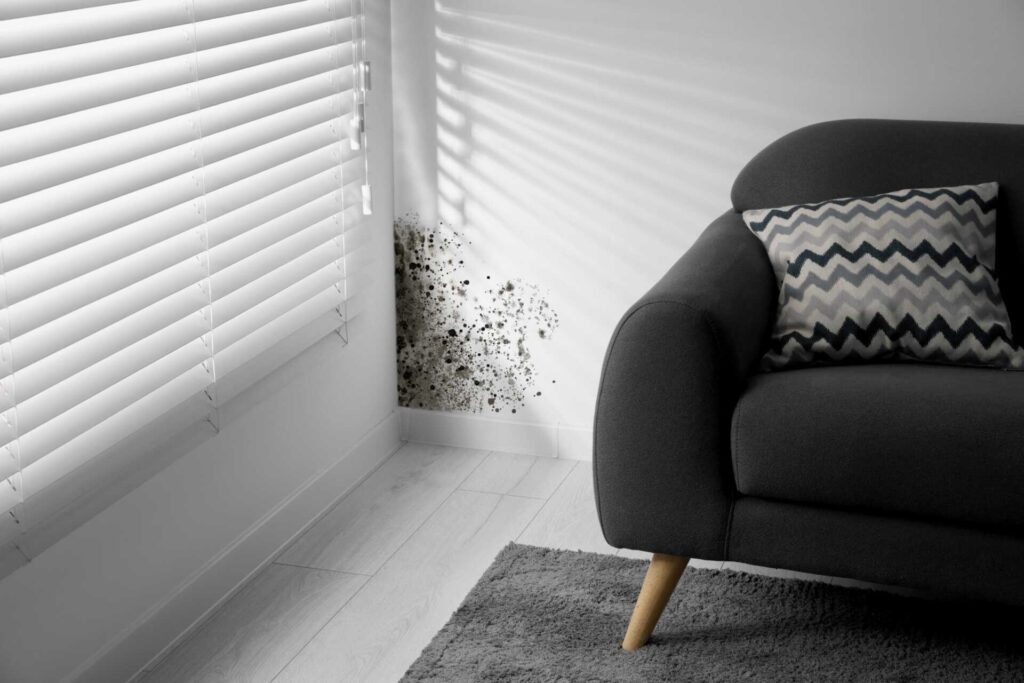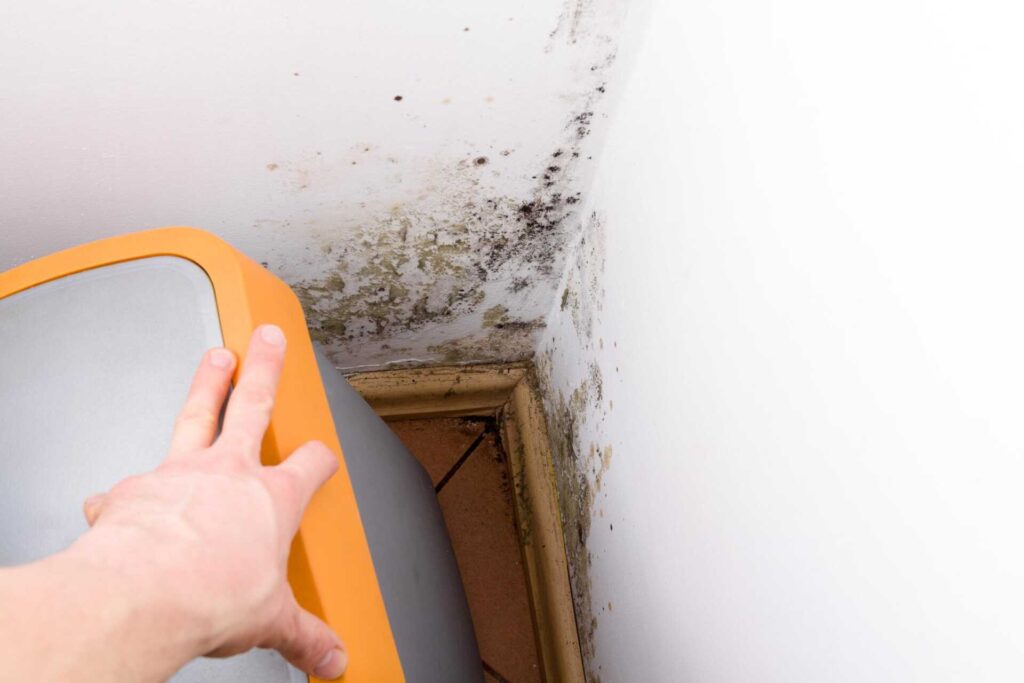
Contents
It’s interesting how many homeowners discover mold right after a heavy rain. If you’ve noticed a musty smell or dark spots in your home, it’s time to act. Identifying where mold hides is essential, but evaluating its extent is just as important. You’ve got safe mold removal techniques at your disposal, but what about preventing it from coming back? Understanding these strategies can make all the difference in maintaining a healthy home.
Key Takeaways
- Identify mold growth by checking damp areas, discoloration, musty smells, and water stains, focusing on bathrooms, kitchens, and basements.
- Gather supplies like gloves, masks, and a cleaning solution, and seal off the affected area before removal.
- Use a water and vinegar mix to spray affected areas, scrub with a brush, and rinse thoroughly to eliminate mold.
- Ensure the area is completely dry after cleaning to prevent mold from returning, and control moisture levels with dehumidifiers.
- Consider hiring certified mold specialists for larger infestations, as they use advanced techniques and ensure safe removal practices.
Identifying Mold Growth in Your Home
Have you ever wondered if that strange patch on your wall is mold? Identifying mold growth in your home is essential for maintaining a safe and healthy environment.
Start by checking damp areas like bathrooms, kitchens, and basements. Look for discoloration, typically black, green, or white, and a musty smell that you can’t ignore. Use a flashlight to inspect hidden corners, behind appliances, or under sinks where moisture often collects.
Don’t forget to examine your HVAC system and air ducts, as mold can thrive there, too. If you notice water stains on ceilings or walls, that might indicate a leak, which can lead to mold growth.
Assessing the Extent of Mold Infestation
How can you accurately determine the extent of mold infestation in your home? Start by inspecting areas prone to moisture, like bathrooms, basements, and around windows. Look for visible mold patches, discoloration, or water stains on walls and ceilings.
Next, evaluate the smell. A musty odor often indicates hidden mold, even if you can’t see it. Use a moisture meter to check for elevated humidity levels in your home; anything above 60% can encourage mold growth.
Additionally, consider the size of the affected area. If it’s confined to a small section (less than 10 square feet), you might handle it yourself. However, if it’s more extensive, it’s essential to seek professional help.
Documenting your findings can also help you track progress during remediation. By accurately evaluating the infestation, you’ll take the first step toward a healthier, mold-free home.
Safe Removal Techniques for Homeowners
While tackling mold removal might seem challenging, you can effectively manage small infestations with the right techniques. Start by gathering your supplies: gloves, masks, and a spray bottle with a cleaning solution. A mix of water and vinegar works wonders for non-porous surfaces.
Here’s a quick reference table for safe removal techniques:
| Step | Action |
|---|---|
| 1. Preparation | Seal off the area and wear protective gear. |
| 2. Apply Solution | Spray the solution on the affected area. |
| 3. Scrub and Rinse | Use a scrub brush, then rinse with water. |
After scrubbing, dry the area thoroughly to prevent mold from returning. For larger infestations, it’s wise to consult professionals, but with these techniques, you can confidently address minor issues and create a healthier home environment for you and your loved ones.
Preventing Future Mold Growth
Once you’ve tackled mold removal, the next step is to focus on preventing future growth. Start by controlling moisture levels in your home. Use dehumidifiers in damp areas like basements and bathrooms, and ensure proper ventilation, especially in kitchens and laundry rooms.
Regularly check for leaks in pipes and roofs, and fix them immediately to avoid water accumulation. You should also clean and maintain your gutters to prevent water from seeping into your home.
Consider using mold-resistant materials when renovating, such as paints and drywall designed to inhibit mold growth. Finally, keep your home clutter-free, as items can trap moisture and create an inviting environment for mold.
Utilizing Professional Mold Remediation Services
When facing a mold issue, hiring certified mold specialists can make a significant difference.
They use advanced remediation techniques tailored to your specific situation and conduct a thorough inspection to identify hidden problems.
This professional approach ensures effective removal and helps prevent future outbreaks.
Certified Mold Specialists
Engaging a certified mold specialist can be one of the most effective steps you take to tackle mold issues in your home.
These experts are trained to identify, assess, and remediate mold safely and efficiently. Relying on their knowledge ensures a thorough and lasting solution.
Here are a few benefits of hiring certified mold specialists:
Expert Assessment: They use advanced tools to detect hidden mold and moisture issues.
Safety Protocols: Specialists follow strict safety guidelines to protect your family and pets.
Comprehensive Remediation: They provide a complete plan, ensuring the mold doesn’t return.
With their expertise, you’re not just removing mold; you’re investing in a healthier living environment for you and your loved ones.
Advanced Remediation Techniques
Advanced remediation techniques employed by professional mold remediation services can effectively eliminate mold and prevent its recurrence in your home.
These experts use specialized equipment like HEPA vacuums and air scrubbers to ensure that even microscopic spores are captured. They also apply antimicrobial solutions to surfaces, targeting any remaining mold traces.
Thorough containment strategies prevent spores from spreading during the process, safeguarding your living space. Professionals often utilize advanced drying techniques, such as dehumidifiers, to eliminate moisture, which is key in preventing future growth.
Comprehensive Inspection Process
How can you ensure that every potential mold issue in your home is identified? Utilizing professional mold remediation services is essential for a thorough inspection.
Trained experts can spot problems you might overlook, ensuring your family’s safety and comfort. Here’s what you can expect during the inspection process:
Comprehensive Assessment: Professionals evaluate both visible and hidden areas prone to mold.
Advanced Technology: They use specialized tools, like moisture meters and thermal imaging, to detect damp spots.
Detailed Report: You’ll receive a clear report outlining findings and recommended actions.
Maintaining a Mold-Free Environment
To keep your home mold-free, establish regular cleaning routines that target areas prone to dampness.
It’s also essential to control humidity levels by using dehumidifiers and ensuring proper ventilation throughout your space.
Regular Cleaning Routines
Establishing a regular cleaning routine is essential for keeping your home mold-free. By consistently cleaning and maintaining your spaces, you can greatly reduce mold growth and ensure a healthier environment for you and your loved ones.
Here are some key practices to incorporate:
Dust surfaces weekly to prevent mold spores from settling.
Mop floors and wipe down surfaces with a mold-inhibiting cleaner bi-weekly.
Check and clean your bathrooms regularly, especially around sinks and tubs where moisture accumulates.
Control Humidity Levels
Maintaining ideal humidity levels is essential for preventing mold growth in your home. Aim for a humidity range of 30% to 60%. You can easily measure humidity with a hygrometer.
If levels are too high, consider using a dehumidifier, especially in damp areas like basements and bathrooms. Regularly check and fix leaks in plumbing or roofs, as they can contribute to excess moisture.
When cooking or showering, use exhaust fans to help reduce humidity. It’s also beneficial to open windows on dry days to allow fresh air to circulate.
Proper Ventilation Practices
While controlling humidity is key, proper ventilation practices are equally essential in preventing mold growth.
Confirming that air circulates freely throughout your home helps reduce moisture build-up and keeps your environment healthy.
Here are some practical steps you can take:
- Use exhaust fans in bathrooms and kitchens to draw out humid air.
- Open windows whenever possible to encourage fresh air flow, especially after showering or cooking.
- Inspect and clean air vents regularly to verify they’re not obstructed and can effectively circulate air.
Implementing these ventilation strategies combats mold and creates a more inviting atmosphere for you and your loved ones.
Embrace these practices to maintain a welcoming, mold-free home!
Review
By following these strategies, you can keep your home mold-free, like a fortress guarding against an invading army. Identify and assess mold growth, tackle it safely, and implement preventive measures. Remember, it’s not just about removing mold; it’s about creating an environment where it can’t thrive. Regularly check for leaks and maintain ventilation, ensuring your home remains a sanctuary of health and comfort. Don’t hesitate to call in the professionals if needed; your peace of mind is worth it.

